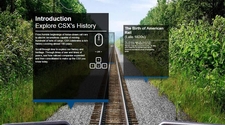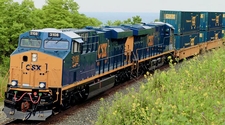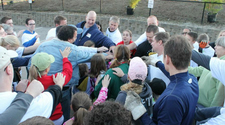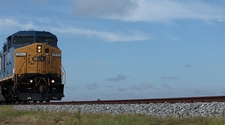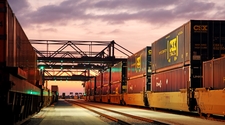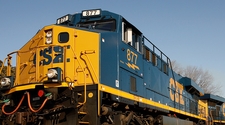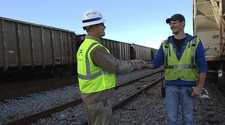| C/O Party |
An intermediary firm or company which receives shipped goods on behalf of the consignee. |
| Cab |
The space in the locomotive unit containing the operating controls and providing shelter and seats for the engine crew. |
| Cab Signal |
A signal located in the enginemen's compartment or cab, indicating a condition affecting the movement of a train or engine and used in conjunction with interlocking signals and in conjunction with or in lieu of block signals. |
| Cabin Car |
See Caboose. |
| Cable |
Either a stranded conductor (single conductor cable) or a combination of conductors insulated from one another (multiple conductor cable). |
| Caboose |
A car which is attached to the rear of a freight train and serves as office and headquarters for the conductor and trainmen while they are in transit. Sometimes called cabin car, way car, hack, shanty, or crummy. |
| Caboose Valve |
A rotary type brake application valve located in the caboose for the purpose of making either a service or emergency brake application. |
| Caller |
See Crew Dispatcher. |
| Camp Car |
A term commonly applied to a car used as a place of lodging for workmen. |
| Cantilever |
A vertical structure with a top projecting horizontal structure used to support a signal mast. |
| Capacitor (Condenser) |
A device, the primary purpose of which is to introduce capacitance into an electric circuit. |
| Capacity (Freight Car) |
The normal load in pounds, cubic feet, or gallons which the car is designed to carry. These figures are stenciled on the car and are identified as "CAPY". Capacity is not to be confused with load limit, which is the maximum weight that can be loaded on a given car. |
| Capitalized Costs |
Expenditures that have future benefit and thus are recorded as assets. |
| Caps |
Torpedoes. |
| Car Day |
An expression referring to the number of days a car owned by one railroad is on the line of another railroad. |
| Car Distribution |
Movement of cars from a surplus area to an area where a shortage exists. |
| Car Distributor |
An individual who is assigned the responsibility of distributing empty freight cars. |
| Car Dumper |
A device for quickly unloading bulk materials such as coal or grain from a freight car. After being clamped to the rail, the car is then tilted or rolled over to discharge the lading. |
| Car Float |
A large flat-bottomed boat equipped with tracks which is used to move railroad cars over waterways. |
| Car Hire |
An hourly charge paid by one railroad for its use of cars belonging to another railroad. |
| Car Initial and Number |
An identification number comprised of initials, which indicate the ownership of the car, and a number, which specifies the type of car. |
| Car Knocker (Slang) |
See Carman. |
| Car Lining |
The material placed on the walls of a car to protect material being transported. |
| Car Management Pools |
Equipment pools where cars are assigned for service to a particular commodity, industry, or location by Car Management to fill car orders. |
| Car Mile |
The movement of a car the distance of one mile. A term used in statistical data. |
| Car Movement Book |
A historical listing, on microfiche, of all car movements arranged first in alphabetical order by car initial, then in ascending car number order. |
| Car Number |
An identification number comprised of initials, which indicate the ownership of the car, and a number, which specifies the type of car. |
| Car Order |
A railroad document used to direct a particular type of empty equipment for loading at an industry. OR Common term used for Car Service Rules, Special Car Orders and Circulars. |
| Car Ownership |
A term which refers to the party to which a car belongs. Possible types of car ownership are CSX owned, CSX leased, private, and foreign. |
| Car Pooling |
The pooling of transportation equipment by several carriers for the mutual benefit of the carriers and industry. Pooling agreements assign operational control to a central agency and establish the terms under which revenue and expenses will be shared by the individual car owners. |
| Car Puller (AKA Car Mover) |
A vehicle, machine, or mechanical device used in shops and certain industries to move freight cars to desired locations. |
| Car Retarder |
A braking device, usually power-operated, built into a railway track to reduce the speed of cars by means of brake shoes which, when set in braking position, rests against the sides of the lower portions of the wheels. |
| Car Seal |
A device fastened to the doors of a car, trailer or container to prevent tampering. |
| Car Service |
The general service of distributing and handling railroad cars. |
| Car Service Orders |
Directives issued by STB which instruct railroads regarding the handling of extraordinary situations. |
| Car Service Rules |
Rules established by agreement between railroads which deal with the interchange of cars, the selection of cars for loading and the return of foreign cars to the home road, either loaded or empty. |
| Car Stop |
A device for stopping motion of a car by engaging the wheels, as distinguished from a bumping post, which arrests motion of the car upon contact with the car's coupler. |
| Car Utilization |
Ways to measure railcar productivity. Among the measures are how much freight a car hauled and how many trips it made in a specified period of time. |
| Card Board |
A small board, secured to the outside of a freight car, on which are tacked cards giving shipping directions or warning of dangerous lading, etc. |
| Caretaker (AKA Attendant) |
A person accompanying a shipment which requires special attention while en route. |
| Carload |
The quantity of freight required for application of carload rate. A car loaded to its weight or space capacity. |
| Carload Minimum Weight |
The least amount of weight for which a shipment will be billed at the carload rate. |
| Carload Rate |
A rate applicable to specified minimum carload weight or a carload quantity. |
| Carman |
Car Inspector. Mechanical department employee who inspects and/or repairs cars. |
| Carrier |
Another name for a transportation company. |
| Carrier Convenience |
A term used when the type of car supplied to the customer is not the type of car ordered because of equipment shortage. In cases where a contract or tariff contains a carrier convenience clause, the freight payor is liable for charges based upon the equipment furnished rather than the equipment ordered if the shipper accepts that equipment. |
| Carrier's Lien |
Right of carrier to retain property which it has transported as security for the collection of charges. |
| Cartage |
The charge made for hauling freight to or from terminals. |
| Cash Customer |
A customer who has never requested credit with the railroad or has been placed on a cash basis because of delinquency problems. Either situation requires payment of freight charges prior to railroad release of lading. |
| Cash Flow Problem |
Customer does not have sufficient funds to pay freight bills within the credit period. |
| Cell |
Battery elements with electrolyte and container. |
| Center Beam (AKA Center Sill) |
The longitudinal structural member of a car underframe, often constructed as a large box section or hat section. The center sill receives all of the buff and draft forces created in train handling and switching. |
| Center Dump Car |
A car which will discharge its entire load between the rails. |
| Center Pin |
A large steel pin which passes through the center plates on the body bolster and truck bolster. The truck turns about the bolt, and stress is taken by the center plates. |
| Center Plate |
One of a pair of plates which fit one into the other and support the car body on the trucks allowing them to turn freely under the car. |
| Centralized Traffic Control |
A term applied to a system of railroad operation by means of which the movement of trains over routes and through blocks on a designated section of track or tracks is directed by signals controlled from a designated section of track or tracks without requiring the use of train orders and without the superiority of trains. |
| Centralized Traffic Control System (CTC) |
A semi-automated means of ensuring rapid and safe movement of trains. |
| Centralized Train Dispatching System (CTDS) |
A system by which train and on-track equipment movements are governed by controlled signals and/or instructions of a train dispatcher from a centralized location. |
| Certificate of Weight |
A sworn or authoritative document stating the weight of a shipment. |
| Chain Gang |
When a number of extra trains (not regularly scheduled freight runs) are put into service, regular crews may be assigned to take such trains in turn. When this occurs, train crews are said to be operating in chain gang service. |
| Chain Tie Down |
A common type of device for securing a load to the deck of a car. Used to secure wheeled vehicle and lumber products on flat cars. |
| Chargeable Day |
A day for which demurrage charges are due and cannot be offset by credits. |
| Charging and Recharging |
The term used to describe the flow of air into the air brake system to raise it to the required pressure. |
| Charging Rate |
The charging rate of a storage battery is the current expressed in amperes at which the battery is charged. |
| Chariot |
Caboose. |
| Chassis (AKA Bogie) |
A frame with truck tires used to transport containers over the highway. |
| Chock |
A piece of sound wood or other material, placed firmly against the wheel of a freight car and on the ball of the rail to prevent cars from rolling away. Used in conjunction with the car's hand brake. |
| Chock Chains |
Chains of a specified size and design, placed across the rail and against the wheel of an engine to prevent unattended engines from rolling away. They are also used in conjunction with the locomotive's brake system. |
| Chord
|
Geometrical term describing a straight line connecting two points on a curve. |
| Circuit Breaker |
A device (other than a fuse) constructed primarily for the interruption of a circuit. |
| Circuitous Route |
An extremely indirect route. Many rate scales and routing guides contain maximum circuity limitations. Often a broker will attempt to employ a circuitous route in order to allow himself leeway to locate a purchaser en route. |
| Circulars |
Publications which list prices negotiated between railroads, or establish conditions for handling shipments which are exempt from regulations under the Interstate Commerce Act. |
| Circus Loading |
A term used to describe an older method of loading highway trailers on TOFC flatcars, whereby a tractor backs the trailer up to a ramp placed at one end of a cut of cars. Circus loading requires bridge plates at each end of all cars to enable the trailer and tractor to pass from car to car. |
| Circus Ramp |
A TOFC ramp used by a truck tractor to move the trailers down a ramp from the flat car to the ground. Called a circus ramp because it's the same way a circus unloads its wagons for a show. |
| Claim |
A demand made upon a carrier for payment due to overcharge or a loss sustained through carrier neglect. OR A demand made upon a carrier for additional pay, based on provisions of the employee's contract. |
| Claim Tracer |
A request for information concerning the status of a claim. |
| Class and Commodity Tariff |
A tariff containing both class and commodity rates. |
| Class Rate |
A monetary charge based on an assigned class rating (a percentage of Class 100) published in the Uniform Freight Classification. |
| Class Rating |
The grouping, based on common characteristics, such as value per unit, weight per unit of volume, or susceptibility to damage, to which a material is assigned. No consideration is made for frequency, direction, or volume of movement. |
| Classification (Refers to Uniform Freight Classification) |
A publication containing a list of articles, the classes to which they are assigned, and the rules and regulations governing their transportation. |
| Classification Code |
A destination and routing code used on switch lists for ease in switching cars. |
| Classification Switching |
The sorting and assembling of railway cars in station or delivery order for making up or breaking up trains or yard cuts. Cars are sorted and assembled by their destination. |
| Classification Yard |
The place where cars are segregated by carriers according to their destinations or deliveries and are made ready for proper train movement or delivery. |
| Clean Bill of Lading |
A bill of lading received by carrier for merchandise in good condition which does not bear any notation such as "shipper's load and count." |
| Cleaning Track |
Area in yard where cars are washed, swept, or upgraded by minor repairs. |
| Clear Alley (Slang) |
A track that is empty of other cars. |
| Clear Board |
A signal indication displayed to advise that no train orders are being held. See Board. |
| Clear Record |
A record that shows that a shipment was handled without any loss or damage. OR Refers to an employee's record that is free of disciplinary entries. |
| Clearance or Clearance Limits |
The dimensions beyond which the size of or projections on a shipment may not extend in order to clear obstructions such as tunnels, switch stands, platforms, bridges, utility poles, or other hazards along the right of way. |
| Clearance Point |
The location on a turnout at which the carriers' specified clearance is provided between tracks. |
| Clearance-Implicated Shipment |
Any shipment loaded on a flat car, gondola, or moving on its own wheels, which also exceeds published clearance limitations for the specific route of movement and/or otherwise restricted shipment requiring specific operating handling procedures for safe movement. |
| Clears |
When a payment, adjustment, or correction is applied to an open item and leaves a zero balance due. |
| Closed File |
An item in the Accounts Receivable file which has had the balance due brought to zero and the intercarrier revenue has been settled. |
| Closed Route |
A route predetermined by the shipper which specifically lists the carriers, junction points and switching lines a train is to travel, example: CSXT-Jacvl-FEC. |
| Coastwise |
Shipments moving by water between two ports on the same coast. |
| COFC (Container on Flat Car) |
Freight loaded in containers and transported by rail on flat cars. Sometimes called piggyback, pig, or tote. |
| Coil Steel Car |
A gondola specially fitted to haul coil steel. |
| Coke Rack |
A slatted frame or box applied above the sides and ends of gondola or hopper cars to increase the cubic capacity for the purpose of carrying coke or other freight in which the bulk is large relative to the weight. |
| Coke Train |
A unit train carrying only carloads of coke. |
| Collect |
A shipment for which the destination carrier is responsible for collection of freight charges, usually from the consignee. |
| Collect Freight Bill |
A freight bill rendered by a transportation line at destination to the freight payor, giving a description of the freight, name of shipper, point of origin, weight, and amount of charges due. |
| Collection on Delivery |
Cost of goods and any charges collected at time carrier delivers goods to consignee. |
| Color Light Signal |
A fixed signal that displays aspects by the color of a light. It may also display aspects by a combination of colored lights. |
| Color Position Light Signal (CPL) |
A fixed signal that displays aspects by the color or position of two or more lights. It consists of a cluster of colored lights normally displayed in pairs. For some aspects, an additional white or yellow light is displayed above or below the cluster. |
| Combination Rate (AKA Aggregate Rate) |
A rate made by combining two or more rates, one of which terminates and the other originates at a common point short of the ultimate destination. A combination rate is applied under the rules and conditions of an aggregate of intermediates clause in the tariff containing the otherwise applicable through rate. |
| Comment Field (ARZ) |
Free form information relating to a patron. |
| Commodity |
Article of commerce (lading). Goods being shipped. |
| Commodity Rate |
A rate applicable to a specific commodity between certain specified points. |
| Commodity Rating |
The grouping in which a material is placed by reason of special consideration, such as frequency, direction, volume of movement, and competitive markets. The grouping is affected to a lesser degree by the value per unit, weight per unit of volume, and susceptibility to damage. |
| Commodity Tariff |
A tariff containing only commodity rates. |
| Common Carrier |
A transportation company that carries property and passengers for compensation. |
| Common Tariff |
A tariff published by or for two or more transportation carriers. |
| Company Material |
Material transported by a railroad, such as coal, rail, crossties, ballast, fuel oil, etc., used in connection with its operations. |
| Compartment Tank Car |
A tank car, the body of which has been divided into sections for transport of multiple commodities or smaller shipments. |
| Compartmentalized Car |
A car equipped with bulkheads. Or a car, the body of which has been divided into several sections for the purpose of carrying different commodities or smaller shipments in each compartment. |
| Competitive Points |
A point at which two or more transportation lines compete for the movement of traffic. |
| Competitive Rate |
A rate established by a transportation line to meet competition of another transportation line. |
| Competitive Traffic |
Traffic in the movement of which two or more transportation lines compete. |
| Composite Scale Test Car |
A short two-axle scale test car with a wheel base of seven feet and consisting of a mold-casted body. |
| Compressor Governor System |
The system that automatically controls loading and unloading of the air compressor to regulate main reservoir pressure between 130 and 140 pounds. |
| Concealed Damage |
Internal damage to the contents of a package which is in good order externally. |
| Conductor |
Train service employee in charge of the train or yard crew. Also called a yard foreman in some parts of the country. |
| Conductor's Wheel Report (AKA Outbound Consist) |
The conductor's report of train movement showing by initials and numbers, or name of the units of equipment handled in the train and the points between which each unit moved. It shows type of car, contents, tons, origin, and destination of all units, plus a recap of total train tonnage. |
| Conflicting Routes |
Two or more routes over which movements cannot be made simultaneously without possibility of collision. |
| Connecting Carrier |
A railroad which has direct physical connection with another railroad or forms a connecting link between two or more railroads. |
| Consignee |
The party to whom articles are shipped. |
| Consignor (AKA Shipper) |
The person or firm by whom articles are shipped. |
| Consist |
Computer-generated document kept at point of origin and advanced to next consisting point listing the train makeup in standing order, the number of passenger and freight cars, commodities, and a summary of the train including tonnage and train length. |
| Consolidator (AKA Shipper Association) |
A company which stores and/or ships merchandise in trailers or containers for beneficial owners, similar to a freight forwarder, but they are organized on a cooperative, nonprofit basis to obtain carload rates and advantages of larger-scale traffic flow for their members. |
| Constructive Placement |
When, due to some disability on the part of the consignor or consignee, a car cannot be placed for loading or unloading and is placed elsewhere, it is considered as being under constructive placement and subject to demurrage rules and charges, the same as if it were actually placed at the designated point. |
| Container |
Weatherproof box designed for bulk shipment of freight. It is generally used for overseas shipments. |
| Container Car |
A flat or open top car, such as a gondola equipped with a number of removable containers which may be lifted off the car and transported to a desired destination. |
| Contamination |
Condition of impurity resulting from mixture of or contact with foreign substance. |
| Continuous Rail |
Rails of standard length which are welded together at the ends to form a single rail of a considerable length. |
| Continuous Seals |
A term denoting that the seals on a car remained intact during the movement of the car from point of origin to destination; or, if broken in transit, that it was done by proper authority and without opportunity for loss to occur before new seals were applied. |
| Continuous Welded Rail (AKA Ribbon Rail, Welded Rail) |
Rail, welded in lengths from 1/4 mile to one mile. |
| Contract |
Written agreement which may contain rates, routes, and/or provisions for specific services. |
| Control Machine |
An assemblage of manually operated levers or other devices for the control of signals, switches or other units, without mechanical interlocking, usually including a track diagram with indication lights. |
| Control Operator |
An employee who directs train traffic by the use of the Direct Traffic Control Block System. |
| Control Station |
A place from which signals and signal appliances are operated. It is also a place from which instructions governing railroad movements are issued. |
| Control Valve |
A device on locomotives and cars that charges, applies, and releases brakes in response to changes in brake pipe pressure. |
| Controlled Point |
A location where the signals and/or switches of a traffic control system are operated and/or controlled from a distant location. |
| Controlled Siding |
A siding equipped with controlled signals that are used to authorize trains to enter or leave the siding. Such signals do not govern movements on the siding. |
| Controlled Signal |
A fixed signal at the entrance of a route or block, it is used to govern the movement of trains using that route or block. The signal is operated from a control station. |
| Controlled Speed |
A speed that will permit stopping within one-half the range of vision. It will also permit stopping short of a train, a car, an obstruction, on-track equipment, or a stop signal. |
| Conversion |
The appropriation of property by a carrier. A wrongful assumption of authority over property belonging to another. |
| Corn Field Meet |
When two trains meet or almost meet head-on because both are trying to use the same tracks. |
| Cornered |
When a car, not in the clear on a track, is struck by a train, engine or car on another track. |
| Corporate Trade |
Method of freight payment reconciliation whereby CSXT furnishes our bank a computer tape of outstanding freight bills three days prior to their due date. Bank personnel match the freight bill numbers debiting the proper account and crediting the CSXT account, clearing the Accounts Receivable file. |
| Correction |
A document issued to change the information on a waybill. |
| Correction List |
A printout of all corrections which have been processed. |
| Country Origin |
Physical location from which raw material was shipped (not transit point), or actual beginning of transit of shipment. |
| Coupler |
A device located at both ends of all cars in a standard location to provide a means for connecting one rail car to another. |
| Covered Gondolas |
Gondolas which have been equipped with some form of removable cover which can be placed over the lading to protect it in transit from weather exposure. Used primarily for loading sheet steel in coils or bundles without the necessity of packing. |
| Covered Hopper Car |
A hopper car with a permanent roof, roof hatches, and bottom openings for unloading. Used for carrying cement, grain, or other bulk commodities. |
| Cow Catcher |
An iron frame on the front of a locomotive or streetcar that clears the track. |
| Credit |
A non-chargeable demurrage day earned on cars released during an accounting month. |
| Credit Letter |
A freight bill tracer automatically generated by the computer 21 days after the freight/incidental bill date, if the bill is not paid or disputed. |
| Crew |
General term used to describe the individuals working together as a unit, such as train crew. |
| Crew Dispatcher (Caller) |
Clerical employee who notifies engine, train, and yard employees when to report for work. |
| Crew Member (AKA Cross Bars) |
A bar with locking devices at each end that fits and locks to belt rails in DF box cars to provide longitudinal restraint for lading. |
| Cripple |
A bad order car. |
| Crossing |
A structure used where one track crosses another at grade, and consisting of four connected frogs. |
| Crossover |
Two turnouts with the track between the frogs arranged to form a continuous passage between two nearby and generally parallel tracks. |
| Crossover Track |
Two turnouts with the track between their frogs arranged to form continuous passage between two nearby and generally parallel tracks. It forms a connection between tracks. |
| Crosstie |
A transverse support, commonly of creosote treated wood, laid in the ballast, on which rails rest to form the track, thereby holding the rails to gauge and evenly distributing the load to the ballast. |
| Crows Nest |
The cupola or box-like structure raised above the roof of a caboose from which a trainman may see along the train while it is in motion. |
| CRT (Cathode Ray Tube) |
A visual display device connected to the computer. |
| Crummy |
See Caboose. |
| CSC |
Customer Service Center in Jacksonville, FL. |
| CSX Train Documentation |
A computer generated document consisting of the following: Tonnage Graph, Restricted or Special Handling List, Clearance Bureau Instruments, Train List and Hazardous Material Description, CT-168 Report, Hazardous Special Handling Instructions, and Train Schedule. |
| CSXCEL |
An internally developed computer program used to directly access and utilize the power of the micro computer. Used by various departments, it affords the user the capability to access four concurrent mainframe sessions and use script language to transfer data between sessions and/or reports. |
| CTC |
See Centralized Traffic Control. |
| Cubic Capacity |
The carrying capacity of a car specified in cubic feet. Cubic feet is determined by multiplying the inside length times width times height (LxWxH = CC). |
| Cupola |
A small cab built on the roof or side of a caboose to afford a means of lookout for the train crew. |
| Curfew |
A timeframe when train traffic is ceased or re-routed so the maintenance of a track or tracks can be performed by Engineering Department personnel. |
| Current of Traffic |
The movement of trains on a main track, in one direction, as specified by the operating rules or special instructions. |
| Cushion Underframe |
A cushioned underframe is designed so that forces acting on the coupler and center sill are lessened by shock absorbing devices. This car is used when transporting fragile commodities. |
| Customer Information Control System (CICS) |
The software used on the CSXT mainframe computer to organize massive amounts of data into manageable units called databases. |
| Customer Pools |
Equipment pools where cars are reserved for loading by a specified shipper only. The customer pays for the privilege of having cars returned to him when empty. |
| Cut |
Several cars coupled together anywhere, such as several cars set out from a train. OR To uncouple a car. OR That part of the right-of-way which is cut through a hill, below ground, etc. |
| Cut It (Slang) |
Phrase meaning that Data Entry has entered data into the computer system for Revenue Accounting. |
| Cut Section |
A location other than a signal location where two joining track circuits end within a block. |
| Cut the Board |
To reduce the number of employees on the extra board. |
| Cut the Jack
|
To cut the engines off.
|
| Cut-Out Cock |
A valve located on locomotives and cars, used to open or close air lines or to cut-in or cut-out air operated devices. When the handle is crosswise to the brake pipe, the cut-out cock is open. When the handle is in-line with the brake pipe, the cut-out cock is closed. |
| CWC
|
Centralized Waybilling Center. Now called Waybill Operations.
|
| CWT |
The initials commonly used in rating to indicate hundredweight. |
| back to top |


